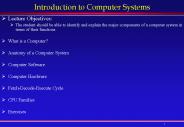Cg: A system for programming graphics hardware in a Clike language
1 / 17
Title:
Cg: A system for programming graphics hardware in a Clike language
Description:
Cg: A system for programming graphics hardware ... Runtime cost of operators not obvious. May not match desired abstraction. Abstraction may not match hardware ... –
Number of Views:22
Avg rating:3.0/5.0
Title: Cg: A system for programming graphics hardware in a Clike language
1
Cg A system for programming graphics hardware in
a C-like language
- Mark, Glanville, Akeley, Kilgard
2
High Level Design Goals
- Ease of programming
- Portability (hardware, OS, API)
- Complete support for hardware functionality
- Performance
- Minimal interference with application data
- Ease of adoption (familiar incremental)
- Extensibility for future hardware
- Support for non-shading uses of the GPU
3
Key Design Decisions
- General Purpose not Domain-Specific
Design goals of performance, minimal management
of application data, and support for non-shading
uses of GPU
- Whereas with Domain-Specific
- Runtime cost of operators not obvious
- May not match desired abstraction
- Abstraction may not match hardware
4
Key Design Decisions
- A Program for Each Pipeline Stage
- Closer match to underlying hardware
- Easier to support branching
- Mix-and-Match vertex pixel kernels
- Specialized stream processing
- Single language for both stream kernels
- Processors omit support for capabilities
- Specific mechanism for attaching kernels
5
Key Design Decisions
- A Program for Each Pipeline Stage
- Data flow interface for inputs outputs
- Cg, HLSL, Assembly language support a modified
bind-by-name scheme (data is put in specific
registers) - Cg also supports bind-by-position where data is
organized in an ordered list - GLSL uses pure bind-by-name where binding of
identifiers to actual hardware is deferred until
kernels are paired
6
Key Design Decisions
- Permit subsetting of the language
Processors are defined by profiles that specify
which subset of the full language is supported by
that processor (GLSL does not support profiles,
however the OpenGL extension mechanism reduces
the significance of this difference)
7
Key Design Decisions
- Modular system architecture
8
Key Design Decisions
- Modular System Architecture
- No Mandatory Virtualization
- Virtualization is most valuable on hardware with
the fewest resources (DX8) which cannot be
effectively virtualized - Resource limits on newer hardware are high
enough that programs exceeding the limits likely
would run too slowly - Requires system to manage both the vertex and
pixel kernels
9
Key Design Decisions
- Modular System Architecture
- Assembly Language Interface
- Compiler can be used as a command-line tool or
invoked via an API at runtime - Assembly code can be further tuned
- Application developer can guarantee a pre-tested
version of the compiler is used - HLSL takes same approach while GLSL integrates
the compiler into the driver
10
Key Design Decisions
- Modular System Architecture
- Explicit program parameters
- All program parameters must be explicitly
declared using non-static globals or via
parameters to the entry function - As in assembly language, parameters can be
passed in untyped via registers - Cg runtime API allows for parameters to be
passed using true names types
11
Cg Language Summary
- Supports
- First-class support for vector and matrix types
- Function overloading as in C
- Operators accept and return scalars vectors
- uniform keyword indicates a variables value
will not vary over a batch of data - out keyword indicates a variable is an output
- structures, arrays, Cs math operators, etc.
12
Cg Language Summary
- Does Not Support
- Recursive functions, switch, goto
- pointers
- bitwise operations
- lacks most C features for programming in the
large (e.g. classes, templates, operator
overloading, exception handling, namespaces)
13
Design Issues
- Hardware Support
- Stream Processor
- uniform and varying keywords identify data types
- Data Types
- multiple numeric types (float, half, fixed) and
bool - vector data types and operators up to length 4
- Indirect Addressing
- not supported in Cg
- read/write parameters implemented via call-by
value-result semantics using in and out as in
Ada
14
Design Issues
- Hardware Support
- Interaction with rest of the graphics pipeline
- certain register identifiers must be supported
as an output by all vertex profiles and certain
identifiers must be supported by all fragment
profiles (e.g. vertex kernel must output a
position vector in a specific register and
fragment shader that modifies a depth value must
write to a particular register) - Shading-specific hardware functionality
- Exposed in a standard library instead of the
language itself (e.g. specific texture sampling)
15
Design Issues
- Other Design Decisions
- User-defined interfaces between modules
- Programmer can define an interface specifying one
or more function prototypes to create
interoperable modules - Function overloading by type and profile
- Constants are typeless (easier modification)
- No type checking for textures
16
Design Issues
- Runtime API
- Compound types are exploded to cross API
- Cg system can shadow parameter values
17
CgFX
- Managing the non-programmable parts
- Functions that execute on the CPU to perform
setup operations - Multi-pass rendering effects
- Configurable graphics state such as texture
filtering modes - Assembly-language GPU programs
- Multiple implementations of a single effect































